Procurement and Logistics Challenges in the Brewing Industry: Analysis
VerifiedAdded on 2022/11/07
|24
|6146
|325
Report
AI Summary
This report delves into the procurement and logistics challenges facing the global brewing industry, which is projected to reach $815.4 billion by 2025. The study highlights the emerging gaps between beer production and consumption markets, with countries like China, India, and Brazil leading consumption while traditional markets experience stagnation. Procurement challenges include climate change-related issues such as drought, heatwaves, and barley shortages, impacting production costs. Logistics issues are also examined, including pressures to reduce carbon emissions, which limit operational capabilities. The research investigates the impact of these challenges on the brewery industry and its stakeholders, answering key research questions about the impact of procurement and logistics on the industry and its stakeholders. The report's objectives, based on the SMART framework, focus on identifying and analyzing these impacts to provide insights for strategic decision-making by brewery firms, wholesalers, retailers, and consumers. The literature review covers key concepts such as procurement, supply chain management, and the challenges in the brewing industry, emphasizing the importance of addressing these issues for the industry's sustainability and stakeholder interests.
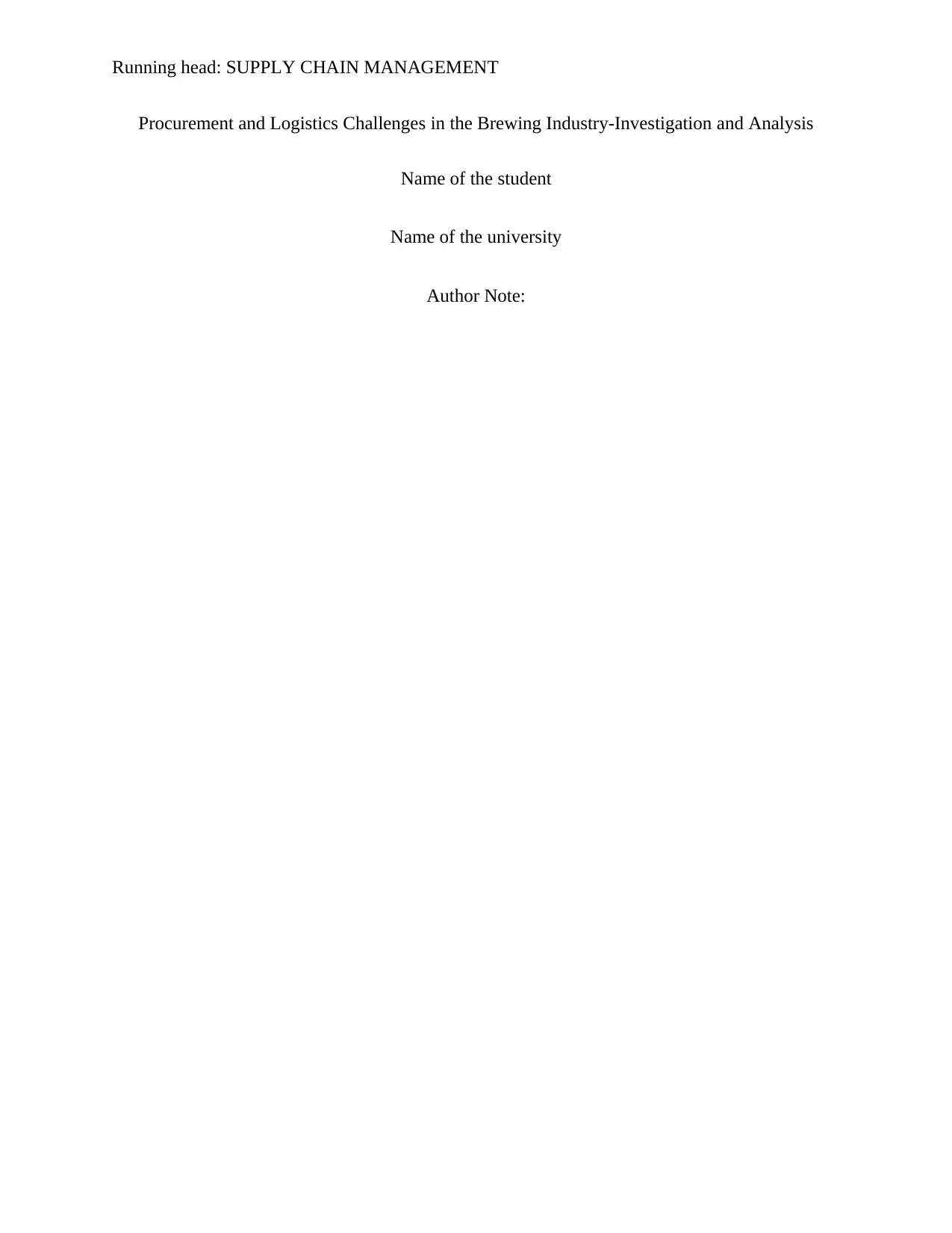
Running head: SUPPLY CHAIN MANAGEMENT
Procurement and Logistics Challenges in the Brewing Industry-Investigation and Analysis
Name of the student
Name of the university
Author Note:
Procurement and Logistics Challenges in the Brewing Industry-Investigation and Analysis
Name of the student
Name of the university
Author Note:
Paraphrase This Document
Need a fresh take? Get an instant paraphrase of this document with our AI Paraphraser
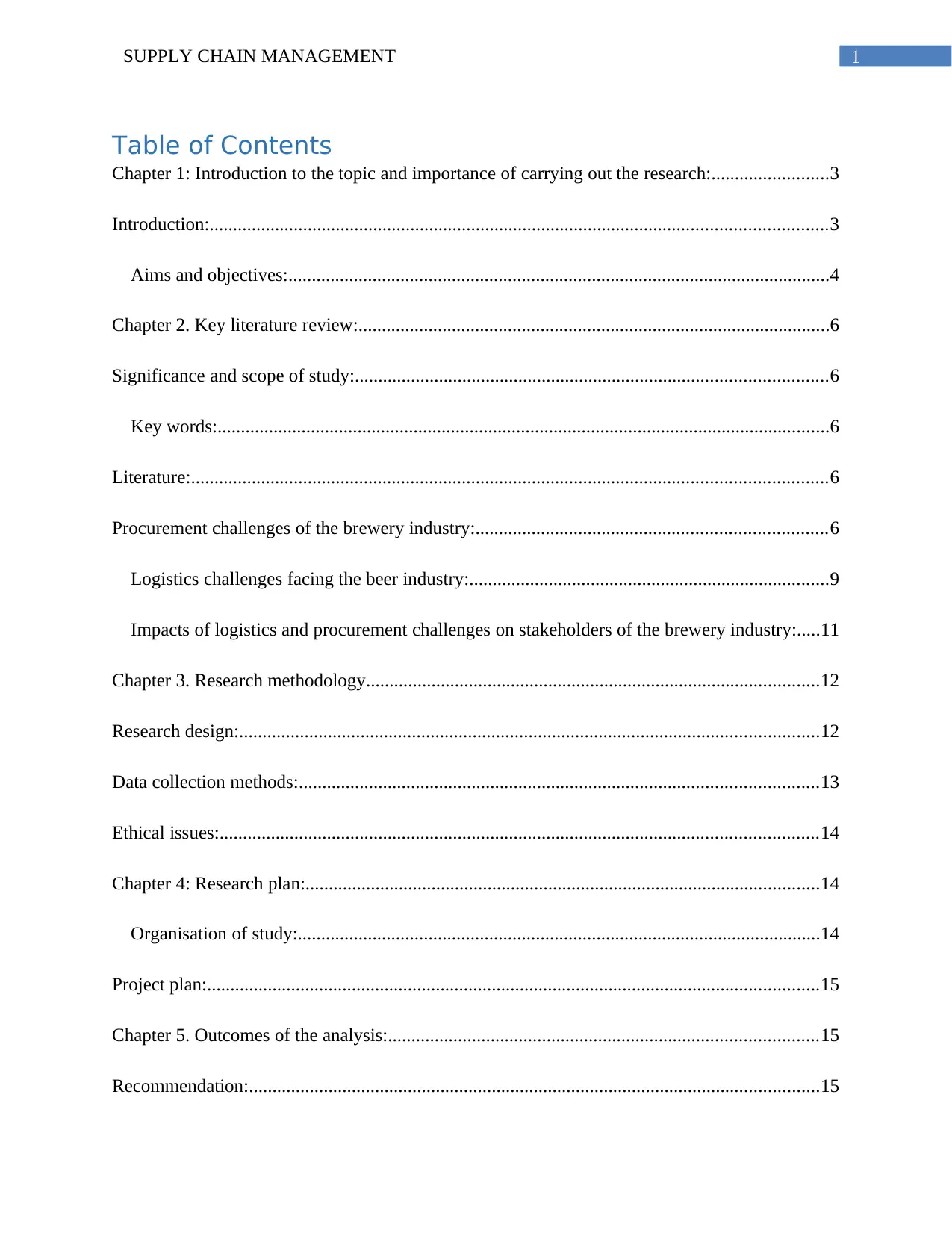
1SUPPLY CHAIN MANAGEMENT
Table of Contents
Chapter 1: Introduction to the topic and importance of carrying out the research:.........................3
Introduction:....................................................................................................................................3
Aims and objectives:....................................................................................................................4
Chapter 2. Key literature review:.....................................................................................................6
Significance and scope of study:.....................................................................................................6
Key words:...................................................................................................................................6
Literature:........................................................................................................................................6
Procurement challenges of the brewery industry:...........................................................................6
Logistics challenges facing the beer industry:.............................................................................9
Impacts of logistics and procurement challenges on stakeholders of the brewery industry:.....11
Chapter 3. Research methodology.................................................................................................12
Research design:............................................................................................................................12
Data collection methods:...............................................................................................................13
Ethical issues:................................................................................................................................14
Chapter 4: Research plan:..............................................................................................................14
Organisation of study:................................................................................................................14
Project plan:...................................................................................................................................15
Chapter 5. Outcomes of the analysis:............................................................................................15
Recommendation:..........................................................................................................................15
Table of Contents
Chapter 1: Introduction to the topic and importance of carrying out the research:.........................3
Introduction:....................................................................................................................................3
Aims and objectives:....................................................................................................................4
Chapter 2. Key literature review:.....................................................................................................6
Significance and scope of study:.....................................................................................................6
Key words:...................................................................................................................................6
Literature:........................................................................................................................................6
Procurement challenges of the brewery industry:...........................................................................6
Logistics challenges facing the beer industry:.............................................................................9
Impacts of logistics and procurement challenges on stakeholders of the brewery industry:.....11
Chapter 3. Research methodology.................................................................................................12
Research design:............................................................................................................................12
Data collection methods:...............................................................................................................13
Ethical issues:................................................................................................................................14
Chapter 4: Research plan:..............................................................................................................14
Organisation of study:................................................................................................................14
Project plan:...................................................................................................................................15
Chapter 5. Outcomes of the analysis:............................................................................................15
Recommendation:..........................................................................................................................15
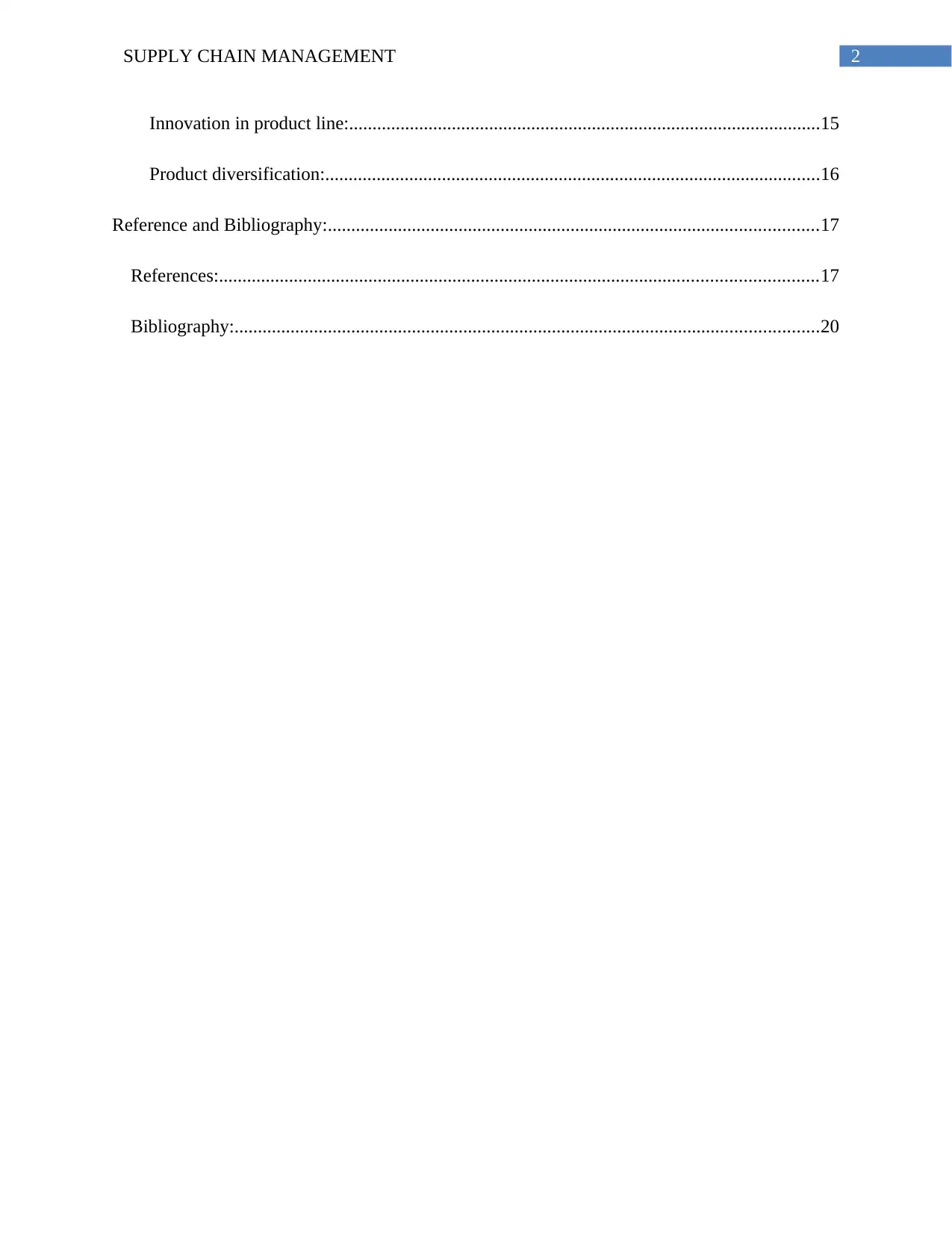
2SUPPLY CHAIN MANAGEMENT
Innovation in product line:.....................................................................................................15
Product diversification:..........................................................................................................16
Reference and Bibliography:.........................................................................................................17
References:................................................................................................................................17
Bibliography:.............................................................................................................................20
Innovation in product line:.....................................................................................................15
Product diversification:..........................................................................................................16
Reference and Bibliography:.........................................................................................................17
References:................................................................................................................................17
Bibliography:.............................................................................................................................20
⊘ This is a preview!⊘
Do you want full access?
Subscribe today to unlock all pages.

Trusted by 1+ million students worldwide
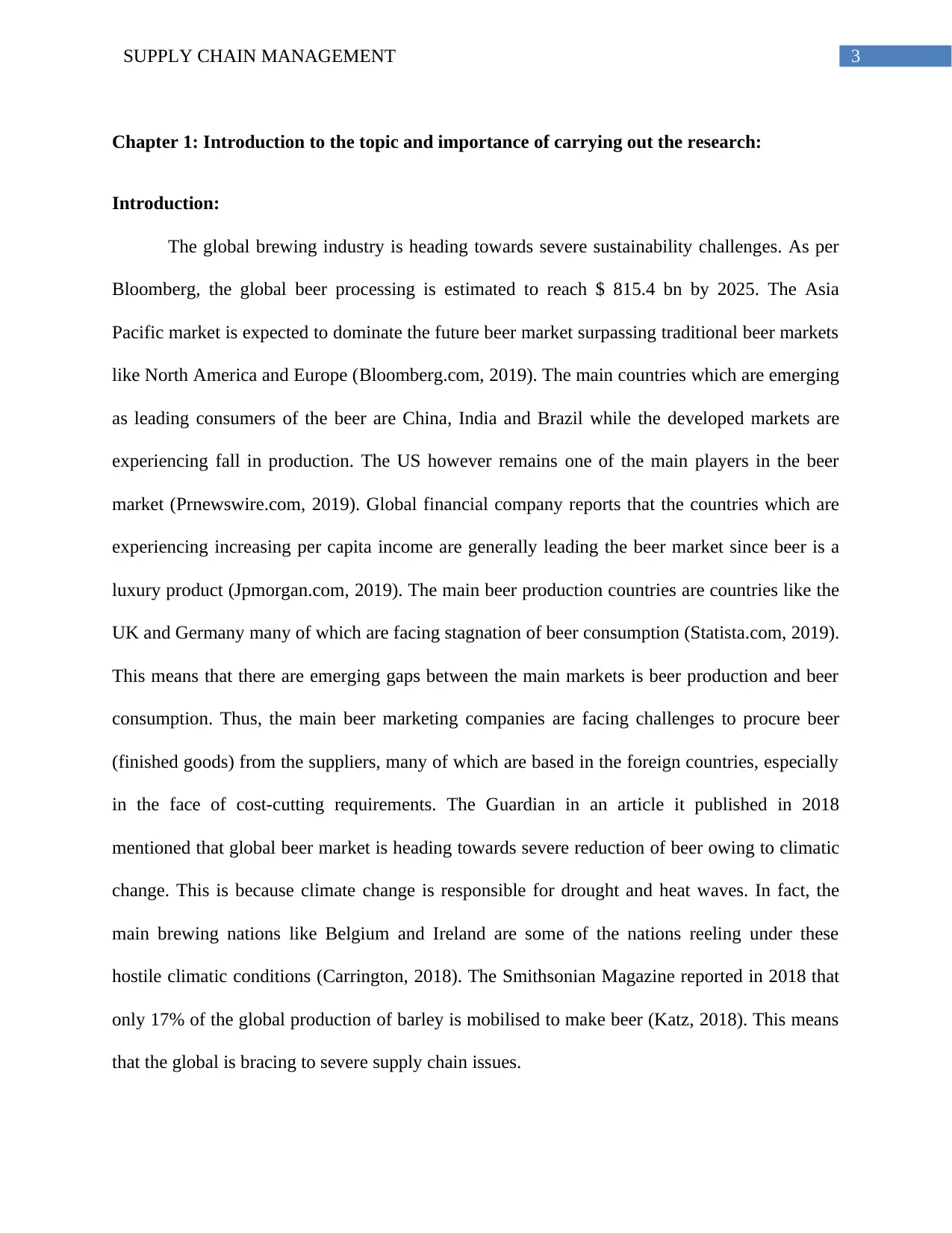
3SUPPLY CHAIN MANAGEMENT
Chapter 1: Introduction to the topic and importance of carrying out the research:
Introduction:
The global brewing industry is heading towards severe sustainability challenges. As per
Bloomberg, the global beer processing is estimated to reach $ 815.4 bn by 2025. The Asia
Pacific market is expected to dominate the future beer market surpassing traditional beer markets
like North America and Europe (Bloomberg.com, 2019). The main countries which are emerging
as leading consumers of the beer are China, India and Brazil while the developed markets are
experiencing fall in production. The US however remains one of the main players in the beer
market (Prnewswire.com, 2019). Global financial company reports that the countries which are
experiencing increasing per capita income are generally leading the beer market since beer is a
luxury product (Jpmorgan.com, 2019). The main beer production countries are countries like the
UK and Germany many of which are facing stagnation of beer consumption (Statista.com, 2019).
This means that there are emerging gaps between the main markets is beer production and beer
consumption. Thus, the main beer marketing companies are facing challenges to procure beer
(finished goods) from the suppliers, many of which are based in the foreign countries, especially
in the face of cost-cutting requirements. The Guardian in an article it published in 2018
mentioned that global beer market is heading towards severe reduction of beer owing to climatic
change. This is because climate change is responsible for drought and heat waves. In fact, the
main brewing nations like Belgium and Ireland are some of the nations reeling under these
hostile climatic conditions (Carrington, 2018). The Smithsonian Magazine reported in 2018 that
only 17% of the global production of barley is mobilised to make beer (Katz, 2018). This means
that the global is bracing to severe supply chain issues.
Chapter 1: Introduction to the topic and importance of carrying out the research:
Introduction:
The global brewing industry is heading towards severe sustainability challenges. As per
Bloomberg, the global beer processing is estimated to reach $ 815.4 bn by 2025. The Asia
Pacific market is expected to dominate the future beer market surpassing traditional beer markets
like North America and Europe (Bloomberg.com, 2019). The main countries which are emerging
as leading consumers of the beer are China, India and Brazil while the developed markets are
experiencing fall in production. The US however remains one of the main players in the beer
market (Prnewswire.com, 2019). Global financial company reports that the countries which are
experiencing increasing per capita income are generally leading the beer market since beer is a
luxury product (Jpmorgan.com, 2019). The main beer production countries are countries like the
UK and Germany many of which are facing stagnation of beer consumption (Statista.com, 2019).
This means that there are emerging gaps between the main markets is beer production and beer
consumption. Thus, the main beer marketing companies are facing challenges to procure beer
(finished goods) from the suppliers, many of which are based in the foreign countries, especially
in the face of cost-cutting requirements. The Guardian in an article it published in 2018
mentioned that global beer market is heading towards severe reduction of beer owing to climatic
change. This is because climate change is responsible for drought and heat waves. In fact, the
main brewing nations like Belgium and Ireland are some of the nations reeling under these
hostile climatic conditions (Carrington, 2018). The Smithsonian Magazine reported in 2018 that
only 17% of the global production of barley is mobilised to make beer (Katz, 2018). This means
that the global is bracing to severe supply chain issues.
Paraphrase This Document
Need a fresh take? Get an instant paraphrase of this document with our AI Paraphraser
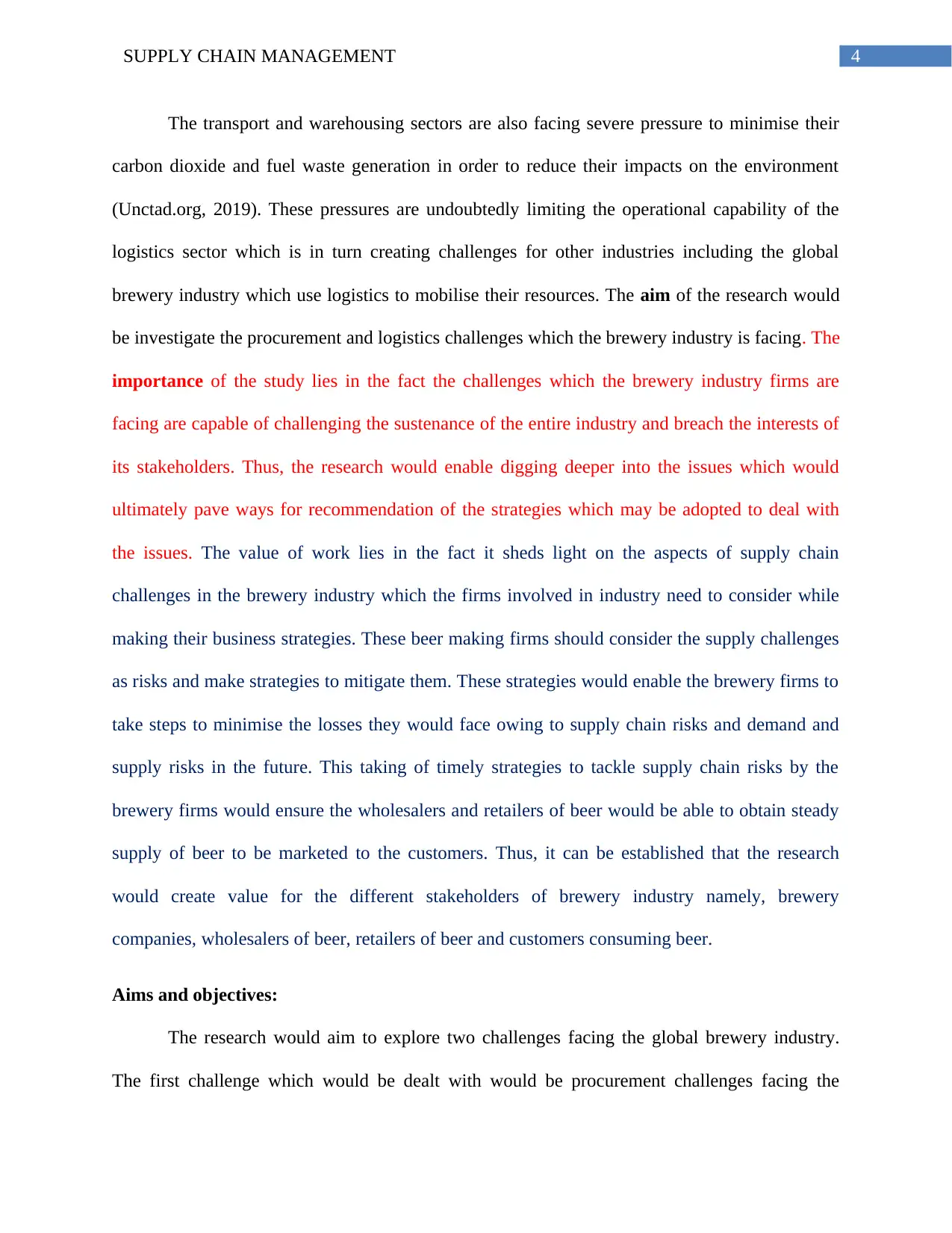
4SUPPLY CHAIN MANAGEMENT
The transport and warehousing sectors are also facing severe pressure to minimise their
carbon dioxide and fuel waste generation in order to reduce their impacts on the environment
(Unctad.org, 2019). These pressures are undoubtedly limiting the operational capability of the
logistics sector which is in turn creating challenges for other industries including the global
brewery industry which use logistics to mobilise their resources. The aim of the research would
be investigate the procurement and logistics challenges which the brewery industry is facing. The
importance of the study lies in the fact the challenges which the brewery industry firms are
facing are capable of challenging the sustenance of the entire industry and breach the interests of
its stakeholders. Thus, the research would enable digging deeper into the issues which would
ultimately pave ways for recommendation of the strategies which may be adopted to deal with
the issues. The value of work lies in the fact it sheds light on the aspects of supply chain
challenges in the brewery industry which the firms involved in industry need to consider while
making their business strategies. These beer making firms should consider the supply challenges
as risks and make strategies to mitigate them. These strategies would enable the brewery firms to
take steps to minimise the losses they would face owing to supply chain risks and demand and
supply risks in the future. This taking of timely strategies to tackle supply chain risks by the
brewery firms would ensure the wholesalers and retailers of beer would be able to obtain steady
supply of beer to be marketed to the customers. Thus, it can be established that the research
would create value for the different stakeholders of brewery industry namely, brewery
companies, wholesalers of beer, retailers of beer and customers consuming beer.
Aims and objectives:
The research would aim to explore two challenges facing the global brewery industry.
The first challenge which would be dealt with would be procurement challenges facing the
The transport and warehousing sectors are also facing severe pressure to minimise their
carbon dioxide and fuel waste generation in order to reduce their impacts on the environment
(Unctad.org, 2019). These pressures are undoubtedly limiting the operational capability of the
logistics sector which is in turn creating challenges for other industries including the global
brewery industry which use logistics to mobilise their resources. The aim of the research would
be investigate the procurement and logistics challenges which the brewery industry is facing. The
importance of the study lies in the fact the challenges which the brewery industry firms are
facing are capable of challenging the sustenance of the entire industry and breach the interests of
its stakeholders. Thus, the research would enable digging deeper into the issues which would
ultimately pave ways for recommendation of the strategies which may be adopted to deal with
the issues. The value of work lies in the fact it sheds light on the aspects of supply chain
challenges in the brewery industry which the firms involved in industry need to consider while
making their business strategies. These beer making firms should consider the supply challenges
as risks and make strategies to mitigate them. These strategies would enable the brewery firms to
take steps to minimise the losses they would face owing to supply chain risks and demand and
supply risks in the future. This taking of timely strategies to tackle supply chain risks by the
brewery firms would ensure the wholesalers and retailers of beer would be able to obtain steady
supply of beer to be marketed to the customers. Thus, it can be established that the research
would create value for the different stakeholders of brewery industry namely, brewery
companies, wholesalers of beer, retailers of beer and customers consuming beer.
Aims and objectives:
The research would aim to explore two challenges facing the global brewery industry.
The first challenge which would be dealt with would be procurement challenges facing the
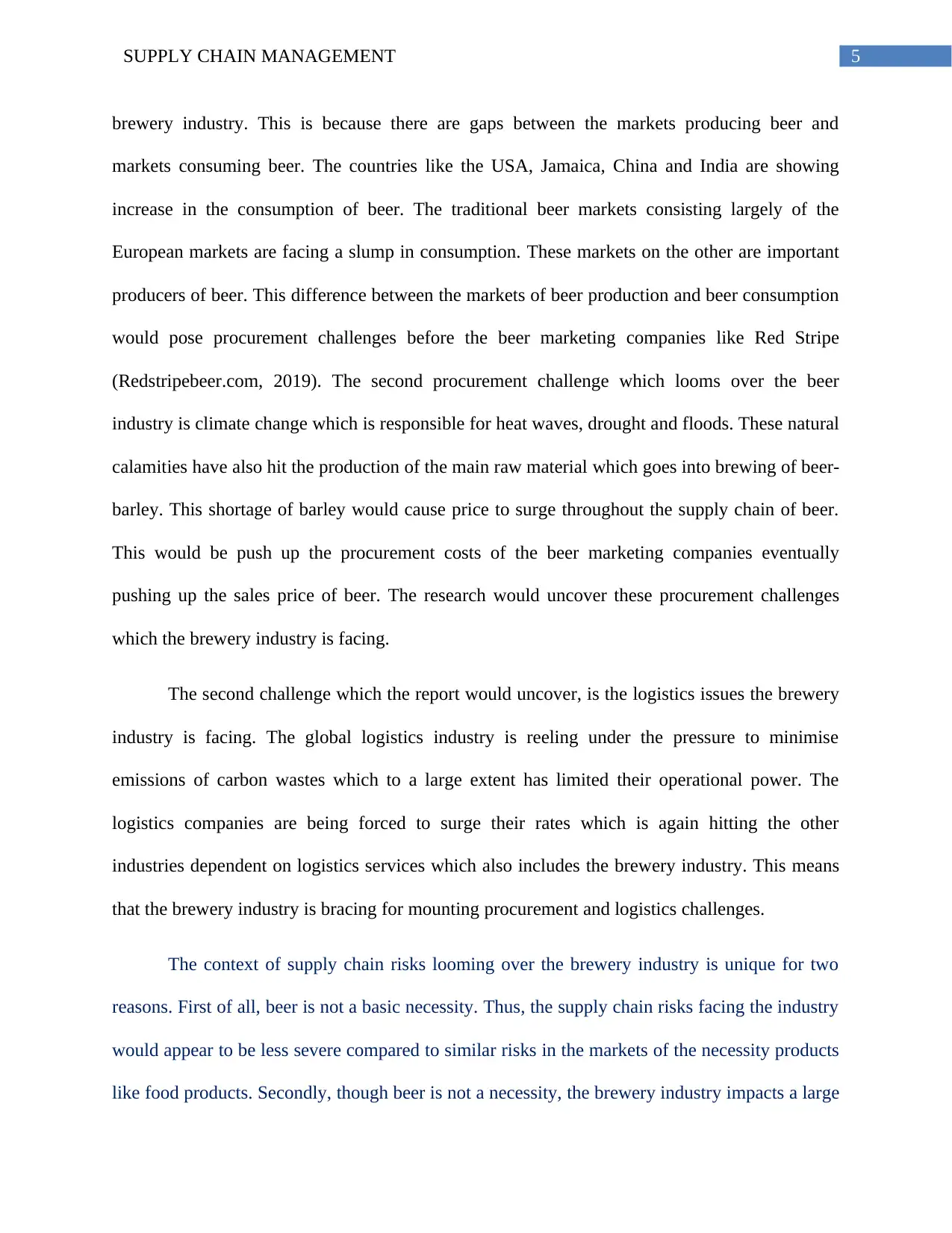
5SUPPLY CHAIN MANAGEMENT
brewery industry. This is because there are gaps between the markets producing beer and
markets consuming beer. The countries like the USA, Jamaica, China and India are showing
increase in the consumption of beer. The traditional beer markets consisting largely of the
European markets are facing a slump in consumption. These markets on the other are important
producers of beer. This difference between the markets of beer production and beer consumption
would pose procurement challenges before the beer marketing companies like Red Stripe
(Redstripebeer.com, 2019). The second procurement challenge which looms over the beer
industry is climate change which is responsible for heat waves, drought and floods. These natural
calamities have also hit the production of the main raw material which goes into brewing of beer-
barley. This shortage of barley would cause price to surge throughout the supply chain of beer.
This would be push up the procurement costs of the beer marketing companies eventually
pushing up the sales price of beer. The research would uncover these procurement challenges
which the brewery industry is facing.
The second challenge which the report would uncover, is the logistics issues the brewery
industry is facing. The global logistics industry is reeling under the pressure to minimise
emissions of carbon wastes which to a large extent has limited their operational power. The
logistics companies are being forced to surge their rates which is again hitting the other
industries dependent on logistics services which also includes the brewery industry. This means
that the brewery industry is bracing for mounting procurement and logistics challenges.
The context of supply chain risks looming over the brewery industry is unique for two
reasons. First of all, beer is not a basic necessity. Thus, the supply chain risks facing the industry
would appear to be less severe compared to similar risks in the markets of the necessity products
like food products. Secondly, though beer is not a necessity, the brewery industry impacts a large
brewery industry. This is because there are gaps between the markets producing beer and
markets consuming beer. The countries like the USA, Jamaica, China and India are showing
increase in the consumption of beer. The traditional beer markets consisting largely of the
European markets are facing a slump in consumption. These markets on the other are important
producers of beer. This difference between the markets of beer production and beer consumption
would pose procurement challenges before the beer marketing companies like Red Stripe
(Redstripebeer.com, 2019). The second procurement challenge which looms over the beer
industry is climate change which is responsible for heat waves, drought and floods. These natural
calamities have also hit the production of the main raw material which goes into brewing of beer-
barley. This shortage of barley would cause price to surge throughout the supply chain of beer.
This would be push up the procurement costs of the beer marketing companies eventually
pushing up the sales price of beer. The research would uncover these procurement challenges
which the brewery industry is facing.
The second challenge which the report would uncover, is the logistics issues the brewery
industry is facing. The global logistics industry is reeling under the pressure to minimise
emissions of carbon wastes which to a large extent has limited their operational power. The
logistics companies are being forced to surge their rates which is again hitting the other
industries dependent on logistics services which also includes the brewery industry. This means
that the brewery industry is bracing for mounting procurement and logistics challenges.
The context of supply chain risks looming over the brewery industry is unique for two
reasons. First of all, beer is not a basic necessity. Thus, the supply chain risks facing the industry
would appear to be less severe compared to similar risks in the markets of the necessity products
like food products. Secondly, though beer is not a necessity, the brewery industry impacts a large
⊘ This is a preview!⊘
Do you want full access?
Subscribe today to unlock all pages.

Trusted by 1+ million students worldwide

6SUPPLY CHAIN MANAGEMENT
numbers of stakeholders like customers, wholesalers and the bars serving beer. Thus, the
uniqueness of the challenges lies in the fact that they may not impact the end customers as much
as supply chain challenges in the food industry would but they would severe affect the business
generation of the business firms operating in the industry like retailers of beer and restaurants
serving beer. The knowledge which would be created as the outcome of the research would
consist of the challenges facing the brewery industry and the impact of the challenges on the
industry as well as its stakeholders like suppliers of beer in the market.
The research would aim to answer the following research questions:
1. Do procurement challenges impact the brewery industry?
2. Do logistics challenges impact the brewery industry?
3. Do logistics and procurement challenges impact the stakeholders of the brewery industry?
The following research objectives which the research would eye to achieve:
1. Impact of procurement challenges on the brewery industry.
2. Impact of logistics challenges on the brewery industry.
3. Impacts of logistics and procurement challenges on the stakeholders of the brewery industry.
SMART analysis of the objectives:
The objectives of the research mentioned above would be based on the SMART (specific,
measurable, achievable, realistic and time based) framework. Firstly, the objectives should be
specific in terms impacts. For example, the impact of the procurement challenges on the brewery
industry like reduction in the production of beer (finished goods) can be specifically pointed out.
The objectives should be measurable. For example, the losses which the brewery firms and their
numbers of stakeholders like customers, wholesalers and the bars serving beer. Thus, the
uniqueness of the challenges lies in the fact that they may not impact the end customers as much
as supply chain challenges in the food industry would but they would severe affect the business
generation of the business firms operating in the industry like retailers of beer and restaurants
serving beer. The knowledge which would be created as the outcome of the research would
consist of the challenges facing the brewery industry and the impact of the challenges on the
industry as well as its stakeholders like suppliers of beer in the market.
The research would aim to answer the following research questions:
1. Do procurement challenges impact the brewery industry?
2. Do logistics challenges impact the brewery industry?
3. Do logistics and procurement challenges impact the stakeholders of the brewery industry?
The following research objectives which the research would eye to achieve:
1. Impact of procurement challenges on the brewery industry.
2. Impact of logistics challenges on the brewery industry.
3. Impacts of logistics and procurement challenges on the stakeholders of the brewery industry.
SMART analysis of the objectives:
The objectives of the research mentioned above would be based on the SMART (specific,
measurable, achievable, realistic and time based) framework. Firstly, the objectives should be
specific in terms impacts. For example, the impact of the procurement challenges on the brewery
industry like reduction in the production of beer (finished goods) can be specifically pointed out.
The objectives should be measurable. For example, the losses which the brewery firms and their
Paraphrase This Document
Need a fresh take? Get an instant paraphrase of this document with our AI Paraphraser

7SUPPLY CHAIN MANAGEMENT
stakeholders would suffer owing to shortage of raw materials to manufacture of beer like barley
can be measured in terms of money. The objectives of the research should be achievable. For
example, the firms in the brewery industry upon identifying the procurement challenges which
they may face in the future, would form strategies to tackle the challenges. Thus, in other words,
they would be able to reduce the losses they would suffer owing to procurement challenges
which would be an achievement. These firms can also set specific deadlines within which would
manage procurement risks at least to a certain extent. Thus, the objectives would be time based.
The objectives which the research would aim to achieve would be realistic. For example, the
strategies which the brewery firms would adopt in order to deal with procurement challenges like
maintaining of contingency inventory of raw materials would be realistic. Thus, it transpires
from the analysis that the objectives would qualify the SMART framework.
Chapter 2. Key literature review:
Significance and scope of study:
The significance of the study lies in the fact that it would explore the impact of the
procurement and logistics issues facing the brewery industry. The brewery industry is expected
to reach a value of $bn 815.4 by 2025 (Bloomberg.com, 2019). The industry supports an
immense base of stakeholders ranging from the management of the firms operating the industry
to the consumers of beer. Thus, these challenges impacting the brewery would also impact
interests of the stakeholders as well. The scope of the study would cover the challenges faced by
procurement and logistics operations of the brewery industry. The scope would also take into
account the impact these two challenges have on the interests of the stakeholders. The scope of
the research would be mainly revolve around the procurement challenges in the brewery
stakeholders would suffer owing to shortage of raw materials to manufacture of beer like barley
can be measured in terms of money. The objectives of the research should be achievable. For
example, the firms in the brewery industry upon identifying the procurement challenges which
they may face in the future, would form strategies to tackle the challenges. Thus, in other words,
they would be able to reduce the losses they would suffer owing to procurement challenges
which would be an achievement. These firms can also set specific deadlines within which would
manage procurement risks at least to a certain extent. Thus, the objectives would be time based.
The objectives which the research would aim to achieve would be realistic. For example, the
strategies which the brewery firms would adopt in order to deal with procurement challenges like
maintaining of contingency inventory of raw materials would be realistic. Thus, it transpires
from the analysis that the objectives would qualify the SMART framework.
Chapter 2. Key literature review:
Significance and scope of study:
The significance of the study lies in the fact that it would explore the impact of the
procurement and logistics issues facing the brewery industry. The brewery industry is expected
to reach a value of $bn 815.4 by 2025 (Bloomberg.com, 2019). The industry supports an
immense base of stakeholders ranging from the management of the firms operating the industry
to the consumers of beer. Thus, these challenges impacting the brewery would also impact
interests of the stakeholders as well. The scope of the study would cover the challenges faced by
procurement and logistics operations of the brewery industry. The scope would also take into
account the impact these two challenges have on the interests of the stakeholders. The scope of
the research would be mainly revolve around the procurement challenges in the brewery
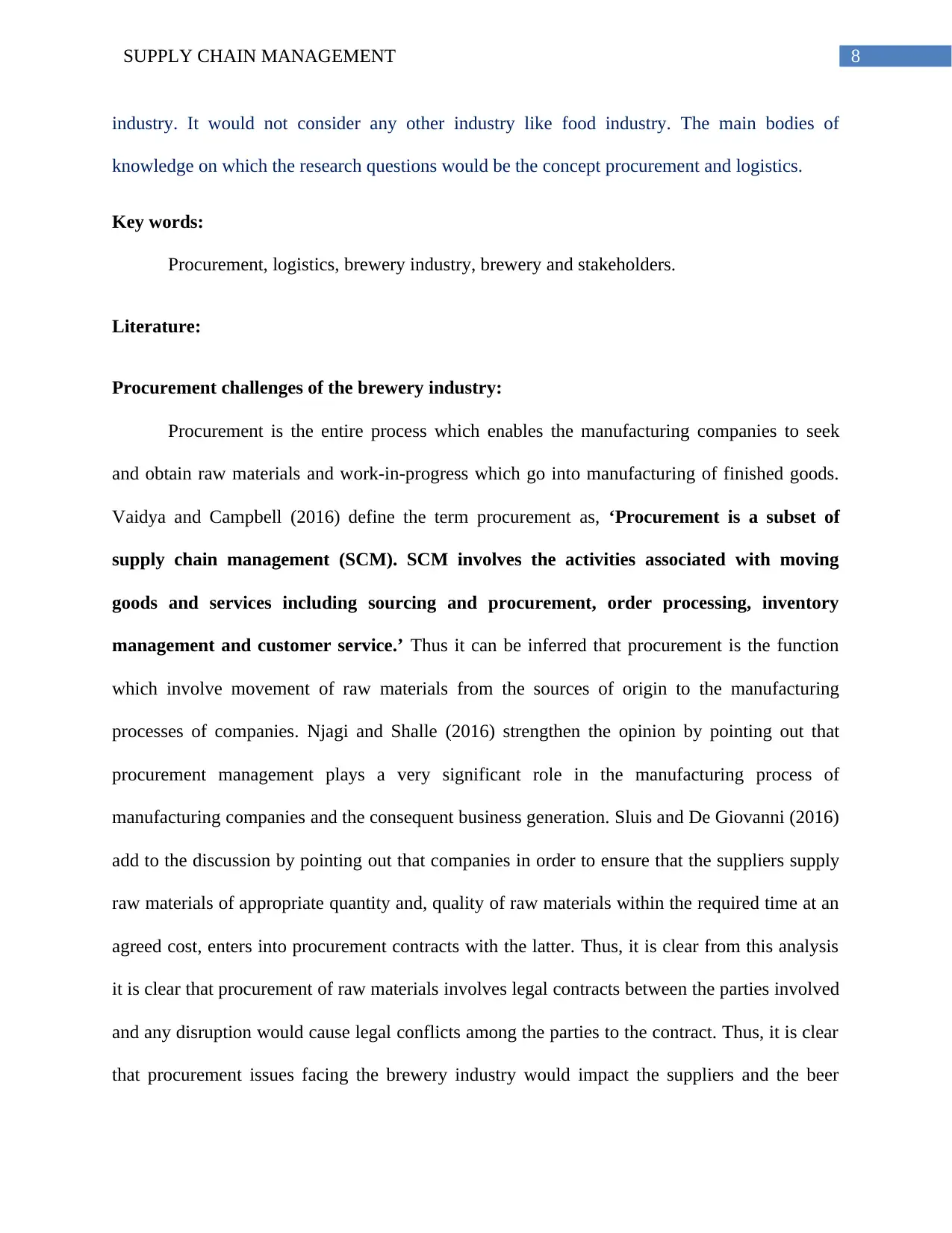
8SUPPLY CHAIN MANAGEMENT
industry. It would not consider any other industry like food industry. The main bodies of
knowledge on which the research questions would be the concept procurement and logistics.
Key words:
Procurement, logistics, brewery industry, brewery and stakeholders.
Literature:
Procurement challenges of the brewery industry:
Procurement is the entire process which enables the manufacturing companies to seek
and obtain raw materials and work-in-progress which go into manufacturing of finished goods.
Vaidya and Campbell (2016) define the term procurement as, ‘Procurement is a subset of
supply chain management (SCM). SCM involves the activities associated with moving
goods and services including sourcing and procurement, order processing, inventory
management and customer service.’ Thus it can be inferred that procurement is the function
which involve movement of raw materials from the sources of origin to the manufacturing
processes of companies. Njagi and Shalle (2016) strengthen the opinion by pointing out that
procurement management plays a very significant role in the manufacturing process of
manufacturing companies and the consequent business generation. Sluis and De Giovanni (2016)
add to the discussion by pointing out that companies in order to ensure that the suppliers supply
raw materials of appropriate quantity and, quality of raw materials within the required time at an
agreed cost, enters into procurement contracts with the latter. Thus, it is clear from this analysis
it is clear that procurement of raw materials involves legal contracts between the parties involved
and any disruption would cause legal conflicts among the parties to the contract. Thus, it is clear
that procurement issues facing the brewery industry would impact the suppliers and the beer
industry. It would not consider any other industry like food industry. The main bodies of
knowledge on which the research questions would be the concept procurement and logistics.
Key words:
Procurement, logistics, brewery industry, brewery and stakeholders.
Literature:
Procurement challenges of the brewery industry:
Procurement is the entire process which enables the manufacturing companies to seek
and obtain raw materials and work-in-progress which go into manufacturing of finished goods.
Vaidya and Campbell (2016) define the term procurement as, ‘Procurement is a subset of
supply chain management (SCM). SCM involves the activities associated with moving
goods and services including sourcing and procurement, order processing, inventory
management and customer service.’ Thus it can be inferred that procurement is the function
which involve movement of raw materials from the sources of origin to the manufacturing
processes of companies. Njagi and Shalle (2016) strengthen the opinion by pointing out that
procurement management plays a very significant role in the manufacturing process of
manufacturing companies and the consequent business generation. Sluis and De Giovanni (2016)
add to the discussion by pointing out that companies in order to ensure that the suppliers supply
raw materials of appropriate quantity and, quality of raw materials within the required time at an
agreed cost, enters into procurement contracts with the latter. Thus, it is clear from this analysis
it is clear that procurement of raw materials involves legal contracts between the parties involved
and any disruption would cause legal conflicts among the parties to the contract. Thus, it is clear
that procurement issues facing the brewery industry would impact the suppliers and the beer
⊘ This is a preview!⊘
Do you want full access?
Subscribe today to unlock all pages.

Trusted by 1+ million students worldwide

9SUPPLY CHAIN MANAGEMENT
manufacturing companies. The first procurement issue which the brewery industry is facing in
disparity of demand and supply in the market. The landscape of the brewery industry is
undergoing drastic changes. The nations which are emerging into leading consumers of beer are
India, China, Jamaica and Brazil. The USA is still one of the main consumers of beer as it was in
the past. The main traditional markets consuming beer like Germany as facing slump in demand
for beer (Prnewswire.com, 2019). One of the main factors encouraging consumption of beer in
these countries is rise in per capita income which is enabling the consumers spend more amount
of their disposable towards purchase of beer (Jpmorgan.com. 2019). Carrington (2018) can be
iterated here to mention that the main nations producing beer nations are facing immense risks
owing to climatic changes. These nations are facing hostile weather conditions like heat waves
and droughts. These hostile weather conditions have damaging impacts on the main raw material
required to manufacture beer-barley. The Smithsonian Magazine mentioned in an article it
published in 2018 that around only 17% of the global barley production in channelized to
manufacture beer. The rest 83% is used to feed animals (Katz, 2018). Thus, it can be pointed out
that hostile climatic conditions would result in reduction of barley which would eventually make
the suppliers supply less amount of barley to the barley making companies. Kuzmin (2016)
throws light the context to point out that shortage in availability of raw materials enable the
suppliers charge more price for the same. Sluis and De Giovanni (2016) can be iterated here to
mention that the procurement is essentially a legal agreement between the suppliers of the raw
materials and the manufacturing firm acquiring the raw materials. The two parties agree amongst
themselves the aspects like quality, quality and prices. Thus, one can point that owing to the
procurement contracts, the beer manufacturing companies have to bear immense procurement
costs. This results in the increase in the costs of manufacturing of beer (Gelderman, Semeijn &
manufacturing companies. The first procurement issue which the brewery industry is facing in
disparity of demand and supply in the market. The landscape of the brewery industry is
undergoing drastic changes. The nations which are emerging into leading consumers of beer are
India, China, Jamaica and Brazil. The USA is still one of the main consumers of beer as it was in
the past. The main traditional markets consuming beer like Germany as facing slump in demand
for beer (Prnewswire.com, 2019). One of the main factors encouraging consumption of beer in
these countries is rise in per capita income which is enabling the consumers spend more amount
of their disposable towards purchase of beer (Jpmorgan.com. 2019). Carrington (2018) can be
iterated here to mention that the main nations producing beer nations are facing immense risks
owing to climatic changes. These nations are facing hostile weather conditions like heat waves
and droughts. These hostile weather conditions have damaging impacts on the main raw material
required to manufacture beer-barley. The Smithsonian Magazine mentioned in an article it
published in 2018 that around only 17% of the global barley production in channelized to
manufacture beer. The rest 83% is used to feed animals (Katz, 2018). Thus, it can be pointed out
that hostile climatic conditions would result in reduction of barley which would eventually make
the suppliers supply less amount of barley to the barley making companies. Kuzmin (2016)
throws light the context to point out that shortage in availability of raw materials enable the
suppliers charge more price for the same. Sluis and De Giovanni (2016) can be iterated here to
mention that the procurement is essentially a legal agreement between the suppliers of the raw
materials and the manufacturing firm acquiring the raw materials. The two parties agree amongst
themselves the aspects like quality, quality and prices. Thus, one can point that owing to the
procurement contracts, the beer manufacturing companies have to bear immense procurement
costs. This results in the increase in the costs of manufacturing of beer (Gelderman, Semeijn &
Paraphrase This Document
Need a fresh take? Get an instant paraphrase of this document with our AI Paraphraser

10SUPPLY CHAIN MANAGEMENT
de Bruijn, 2015). Parise et al. (2017) support the argument by pointing out that beer
manufacturing firms are often forced to either reduce their quantity of production or reduce the
barley content in the beer. While the first results impacts the marketing of beer (finished goods),
the latter results in compromise with quality. Both these outcomes lead to low customer
satisfaction which results in generation of lower amount of revenue. Kuzmin (2016) can be
iterated to point out that increasing manufacturing costs and dipping revenue generations results
in generation of low net profits. The beer manufacturing companies are thus able to give low
returns to their investors. This means that they are able to attract lower amount of capital which
weakens their financially even more. Thus, it transpires from the analysis that procurement
challenges have devastating impacts on the beer industry. These challenges result in shortage in
the availability of the key raw material like barley. The beer manufacturing firms suffer surge in
procurement and manufacturing costs which results in generation of lower profit margins. The
beer manufacturing and marketing companies are forced to compromise with either quality or
quantity of the beer marketed which results in low customer satisfaction and low revenue
generation. Thus, procurement challenges challenge the very financial strength and market
sustainability of the brewery firms. In other words, procurement challenges would have
negative impacts on the brewery industry (problem of the research).
Logistics challenges facing the beer industry:
The brewery industry faces logistics challenges owing to its heavy dependence on
logistics to make beer products available to customers. The markets like China, India, Brazil,
Jamaica and Vietnam are emerging as the main consumers of beer. The United States of America
however retains its position as one of the largest consumers of beer (Prnewswire.com, 2019).
The nations like Germany remain to be major manufacturers of beer but face fall in consumption
de Bruijn, 2015). Parise et al. (2017) support the argument by pointing out that beer
manufacturing firms are often forced to either reduce their quantity of production or reduce the
barley content in the beer. While the first results impacts the marketing of beer (finished goods),
the latter results in compromise with quality. Both these outcomes lead to low customer
satisfaction which results in generation of lower amount of revenue. Kuzmin (2016) can be
iterated to point out that increasing manufacturing costs and dipping revenue generations results
in generation of low net profits. The beer manufacturing companies are thus able to give low
returns to their investors. This means that they are able to attract lower amount of capital which
weakens their financially even more. Thus, it transpires from the analysis that procurement
challenges have devastating impacts on the beer industry. These challenges result in shortage in
the availability of the key raw material like barley. The beer manufacturing firms suffer surge in
procurement and manufacturing costs which results in generation of lower profit margins. The
beer manufacturing and marketing companies are forced to compromise with either quality or
quantity of the beer marketed which results in low customer satisfaction and low revenue
generation. Thus, procurement challenges challenge the very financial strength and market
sustainability of the brewery firms. In other words, procurement challenges would have
negative impacts on the brewery industry (problem of the research).
Logistics challenges facing the beer industry:
The brewery industry faces logistics challenges owing to its heavy dependence on
logistics to make beer products available to customers. The markets like China, India, Brazil,
Jamaica and Vietnam are emerging as the main consumers of beer. The United States of America
however retains its position as one of the largest consumers of beer (Prnewswire.com, 2019).
The nations like Germany remain to be major manufacturers of beer but face fall in consumption
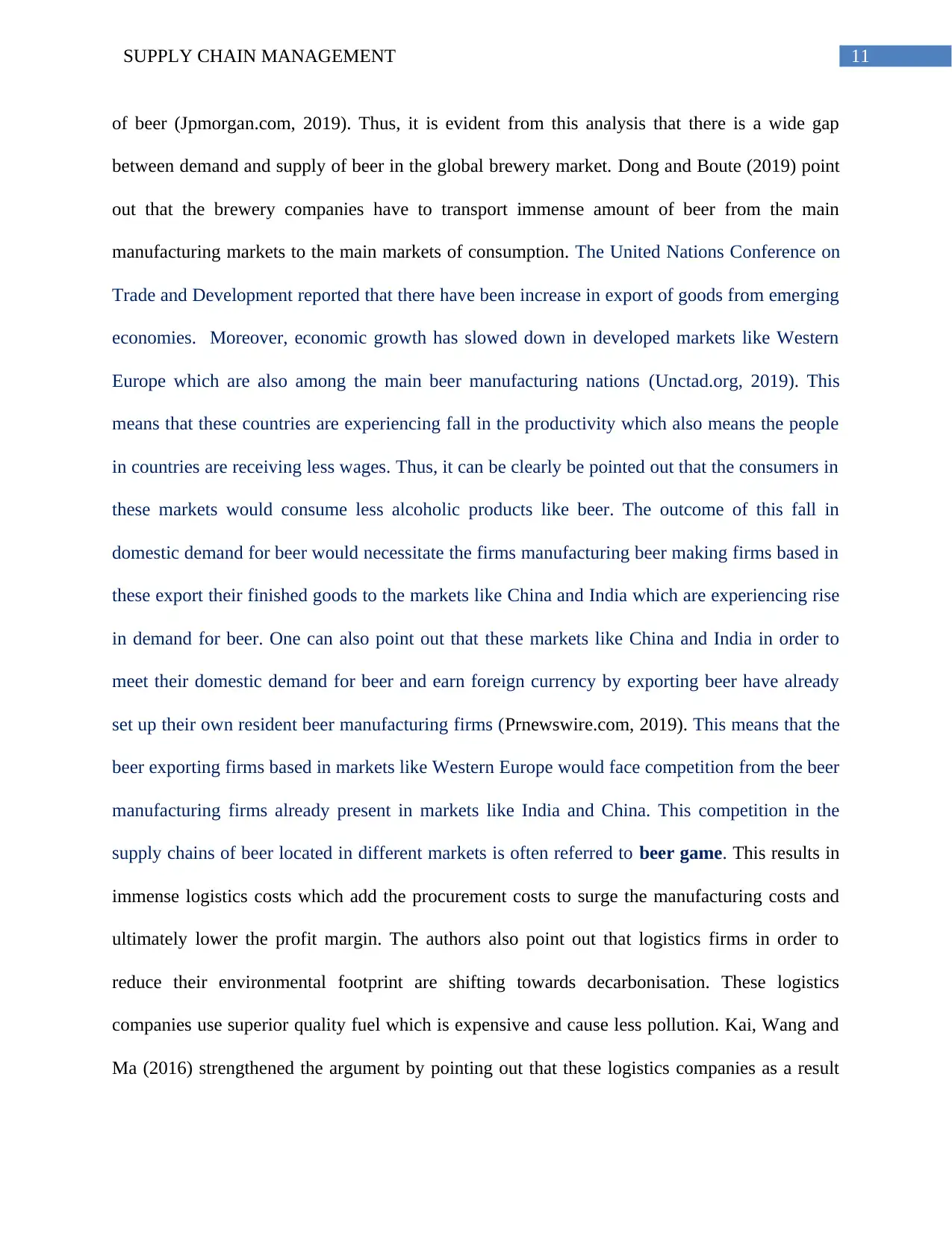
11SUPPLY CHAIN MANAGEMENT
of beer (Jpmorgan.com, 2019). Thus, it is evident from this analysis that there is a wide gap
between demand and supply of beer in the global brewery market. Dong and Boute (2019) point
out that the brewery companies have to transport immense amount of beer from the main
manufacturing markets to the main markets of consumption. The United Nations Conference on
Trade and Development reported that there have been increase in export of goods from emerging
economies. Moreover, economic growth has slowed down in developed markets like Western
Europe which are also among the main beer manufacturing nations (Unctad.org, 2019). This
means that these countries are experiencing fall in the productivity which also means the people
in countries are receiving less wages. Thus, it can be clearly be pointed out that the consumers in
these markets would consume less alcoholic products like beer. The outcome of this fall in
domestic demand for beer would necessitate the firms manufacturing beer making firms based in
these export their finished goods to the markets like China and India which are experiencing rise
in demand for beer. One can also point out that these markets like China and India in order to
meet their domestic demand for beer and earn foreign currency by exporting beer have already
set up their own resident beer manufacturing firms (Prnewswire.com, 2019). This means that the
beer exporting firms based in markets like Western Europe would face competition from the beer
manufacturing firms already present in markets like India and China. This competition in the
supply chains of beer located in different markets is often referred to beer game. This results in
immense logistics costs which add the procurement costs to surge the manufacturing costs and
ultimately lower the profit margin. The authors also point out that logistics firms in order to
reduce their environmental footprint are shifting towards decarbonisation. These logistics
companies use superior quality fuel which is expensive and cause less pollution. Kai, Wang and
Ma (2016) strengthened the argument by pointing out that these logistics companies as a result
of beer (Jpmorgan.com, 2019). Thus, it is evident from this analysis that there is a wide gap
between demand and supply of beer in the global brewery market. Dong and Boute (2019) point
out that the brewery companies have to transport immense amount of beer from the main
manufacturing markets to the main markets of consumption. The United Nations Conference on
Trade and Development reported that there have been increase in export of goods from emerging
economies. Moreover, economic growth has slowed down in developed markets like Western
Europe which are also among the main beer manufacturing nations (Unctad.org, 2019). This
means that these countries are experiencing fall in the productivity which also means the people
in countries are receiving less wages. Thus, it can be clearly be pointed out that the consumers in
these markets would consume less alcoholic products like beer. The outcome of this fall in
domestic demand for beer would necessitate the firms manufacturing beer making firms based in
these export their finished goods to the markets like China and India which are experiencing rise
in demand for beer. One can also point out that these markets like China and India in order to
meet their domestic demand for beer and earn foreign currency by exporting beer have already
set up their own resident beer manufacturing firms (Prnewswire.com, 2019). This means that the
beer exporting firms based in markets like Western Europe would face competition from the beer
manufacturing firms already present in markets like India and China. This competition in the
supply chains of beer located in different markets is often referred to beer game. This results in
immense logistics costs which add the procurement costs to surge the manufacturing costs and
ultimately lower the profit margin. The authors also point out that logistics firms in order to
reduce their environmental footprint are shifting towards decarbonisation. These logistics
companies use superior quality fuel which is expensive and cause less pollution. Kai, Wang and
Ma (2016) strengthened the argument by pointing out that these logistics companies as a result
⊘ This is a preview!⊘
Do you want full access?
Subscribe today to unlock all pages.

Trusted by 1+ million students worldwide
1 out of 24
Related Documents
Your All-in-One AI-Powered Toolkit for Academic Success.
+13062052269
info@desklib.com
Available 24*7 on WhatsApp / Email
![[object Object]](/_next/static/media/star-bottom.7253800d.svg)
Unlock your academic potential
Copyright © 2020–2025 A2Z Services. All Rights Reserved. Developed and managed by ZUCOL.





